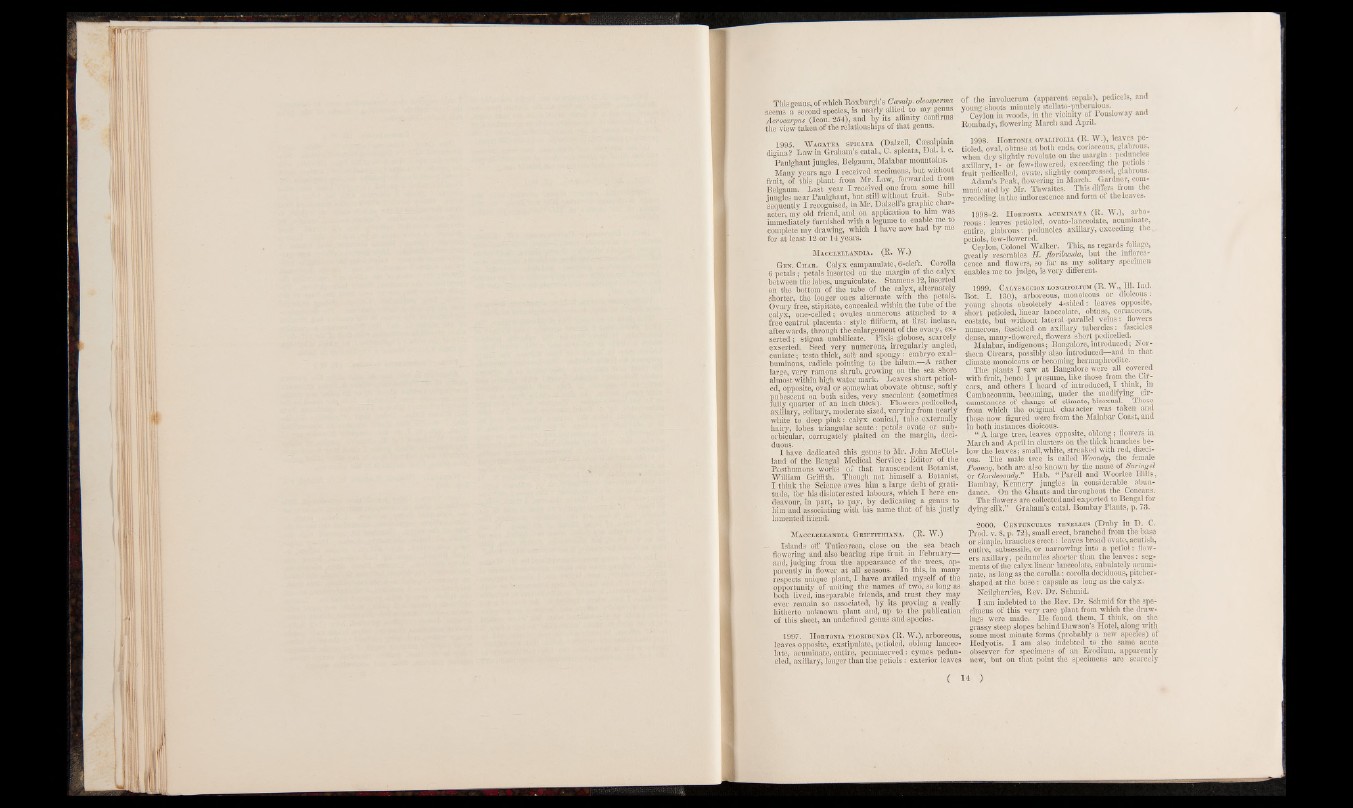
This genus, of which Roxburgh’s Ccesalp. oleosperma
seems a second species, is nearly allied to my genus
Acrocarpus (Icon. 254), and by its affinity confirms
the view taken of the relationships of that genus.
1995. W ag ate a. spicata (Dalzell, Cffisalpinia
digina? Law in Graham’s catal., C. spicata, Dal. 1. c.
Paulghaut jungles, Belgaum, Malabar mountains.
Many years ago I received specimens, but without
fruit, of this plant from Mr. Law, forwarded from
Belgaum. Last year I received one from some hill
jungles near Paulghaut, but still without fruit. Subsequently
I recognised, in Mr. Dalzell’s graphic character,
my old friend, and on application to him was
immediately furnished with a legume to enable me to
complete my drawing, which I have now had by me
for at least 12 or 14 years.
M acceeeeandia. (R. W.)
Gen. Char. Calyx campanulate, 6-cleft. Corolla
6 petals; petals inserted on the margin of the calyx
between the lobes, unguiculate. Stamens 12, inserted
on the bottom of the tube of the calyx, alternately
shorter, the longer ones alternate with the petals.
Ovary free, stipitate, concealed within the tube of the
calyx, one-celled; ovules numerous attached to a
free central placenta: style filiform, at first incluse,
afterwards, through the enlargement of the ovary, ex-
serted; stigma umbilicate. Pixis globose, scarcely
exserted. Seed very numerous, irregularly angled,
cuniate; testa thick, soft/ and spongy: embryo exal-
buminous, radicle pointing to the hilum.—A rather
large, very ramous shrub, growing on the sea shore
almost within high water mark. Leaves short petiol-
ed, opposite, oval or somewhat obovate obtuse, softly
pubescent on both-sides, very succulent (sometimes
fully quarter of an inch thick). Flowers pedicelled,
axillary, solitary, moderate sized, varying from nearly
white to deep pink: calyx conical, tube externally
hairy, lobes triangular acute: petals ovate or sub-
orbicular, corrugately plaited on the margin, deciduous.
, '
I have dedicated this genus to Mr. John McClelland
of the Bengal Medical Service; Editor of the
Posthumous works of that transcendent Botanist,
William Griffith. Though not himself a Botanist,
I think the Science owes him a large debt of gratitude,
for his disinterested labours, which I here endeavour,
in part, to pay, by dedicating a genus to
him and associating with his name that of his justly
lamented friend.
Macceeeeandia Griffithiana. (R. W.)
of the involucrum (apparent sepals), pedicels, and
young shoots minutely stellato-puberulous.
Ceylon in woods, in the vicinity of Pousloway and
Rombady, flowering March and April.
1998. H ortonia ovalifolia (R. W.), leaves petioled,
- Islands off Tuticoreen, close on the sea beach
flowering and also bearing ripe fruit in February—
and, judging from the appearance of the trees, apparently
in flower at all seasons. In this, in many
respects unique plant, I have availed myself of the
opportunity of uniting the names of two, so long as
both lived, inseparable friends, and trust they may
ever remain so associated, by its proving a really
hitherto unknown plant and, up to the publication
of this sheet, an undefined genus and species.
1997. H ortonia floribunda (R. W.), arboreous,
leaves opposite, exstipulate, petioled, oblong lanceolate,
acuminate, entire, penninerved: cymes pedun-
cled, axillary, longer than the petiols : exterior leaves
oval, obtuse at both ends, coriaceous, glabrous,
when dry slightly revolute on the margin: peduncles
axillary, 1- or few-flowered, exceeding the petiols:
fruit pedicelled, ovate, slightly compressed, glabrous.
Adam’s Peak, flowering in March. Gardner, communicated
by Mr. Thwaites. This differs from the
preceding in the inflorescence and form of the leaves.
1998-2. H ortonia acuminata (R. W.), arboreous
: leaves petioled, ovato-lanceolate, acuminate,
entire, glabrous : peduncles axillary, exceeding the^
petiols, few-flowered.
Ceylon, Colonel Walker. This, as regards foliage,
greatly resembles H. floribunda, but the inflorescence
and flowers, so far as my solitary specimen
enables me to judge, is very different.
1999. Caeysaccion eongifolium (R. W., 111. Ind.
Bot. I. 130), arboreous, monoicous or dioicous:
young shoots obsoletely 4-sided: leaves opposite,
short petioled, linear lanceolate, obtuse, coriaceous,
costate, but -without lateral parallel veins: flowers
numerous, fascicled on axillary tubercles: fascicles
dense, many-flowered, flowers short pedicelled.
Malabar, indigenous; Bangalore, introduced; Northern
Circars; possibly also introduced—and in that
climate monoicous or becoming hermaphrodite.
The plants I saw at Bangalore were all covered
with fruit, hence I presume, like those from the Cir-
cars, and others I heard of introduced, I think, in
Combaconum, becoming, under the modifying circumstances
of change of climate, bisexual. Those
from which the original character was taken and
those now figured were from the Malabar Coast, and
f in both instances dioicous.
“ A large tree, leaves opposite, oblong; flowers in
March and April in clusters on the thick branches below
the leaves; small,white, streaked with red, diseci-
ous. The male tree is called Woondy, the female
Poonay, both are also known by the name of Suringel
or Gardeoondy.” Hab. “ Parell and Woorlee Hills,
Bombay, Kennery jungles in considerable abundance.
On the Ghauts and throughout the Concans.
The flowers are collected and exported to Bengal for
dying silk.” Graham’s catal. Bombay Plants, p. 73.
2000. Centuncueus teneleus (Duby in D. C.
Prod. v. 8, p. 72), small erect, branched from the base
or simple, branches erect: leaves broad ovate, acutish,
entire, subsessile, or narrowing into a petiol: flowers
axillary, peduncles shorter than the leaves: segments
of the calyx linear lanceolate, subulately acuminate,
as -long as the corolla: corolla deciduous, pitchershaped
at the base:. capsule as long as the calyx.
Neilgherries; Rev. Dr. Schmid.
I am indebted to the Rev. Dr. Schmid for the specimens
of this very rare plant from which the drawings
were made. He found them, I think, on the
grassy steep slopes behind Dawson’s Hotel, along with
some most minute forms (probably a new species) of
Hedyotis. I am also indebted to the same acute
observer for specimens of an Erodium, apparently
new, but on that point the specimens are scarcely